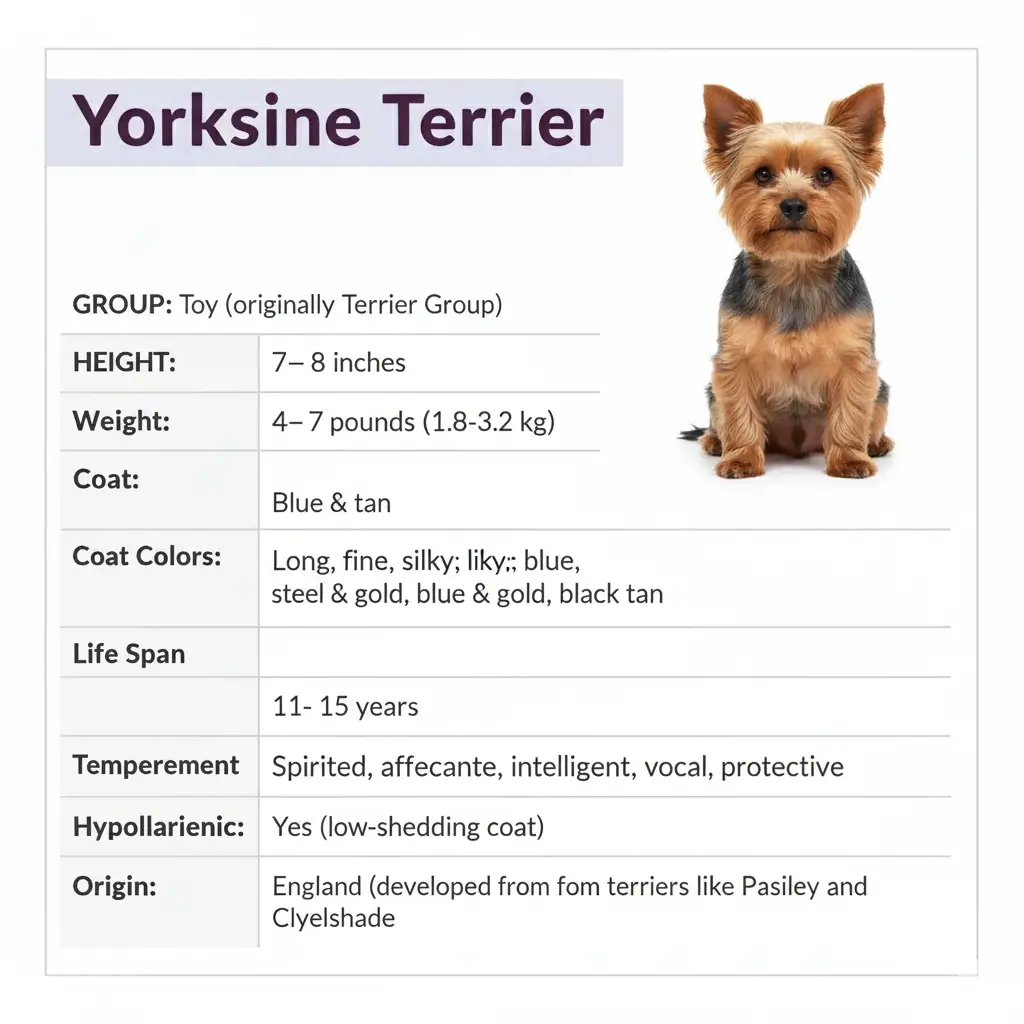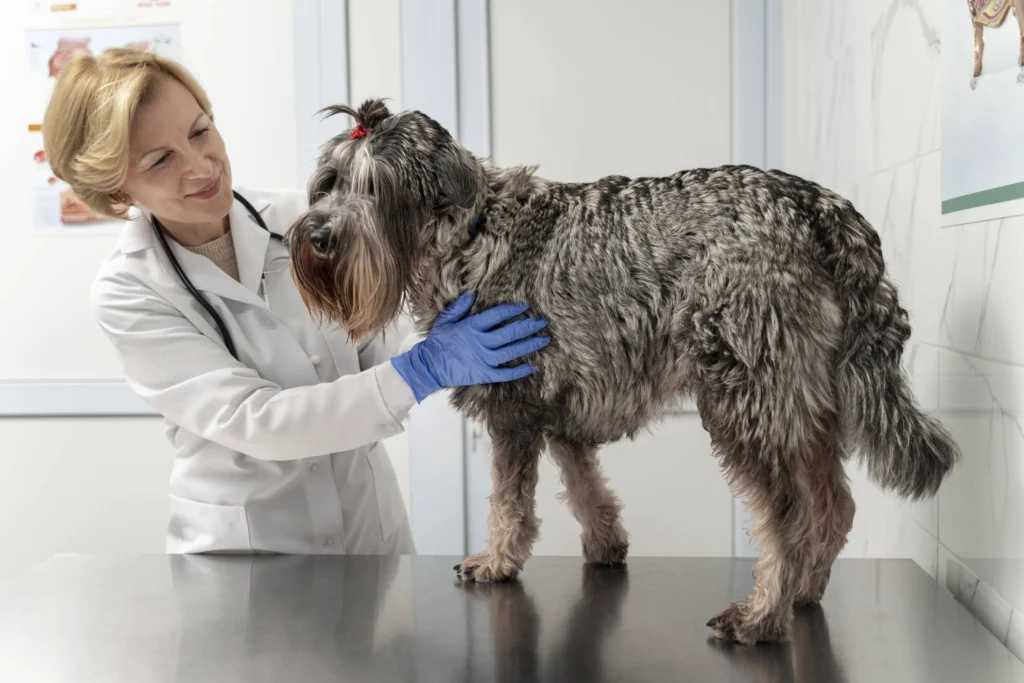What is a Yorkshire Terrier?
The Yorkshire Terrier, affectionately called the Yorkie, is one of the world’s most popular toy dog breeds. Weighing between 4–7 pounds (≈1.8–3.2 kg) and standing 7–8 inches tall, this breed is known for its long, silky, floor-length coat, upright ears, and bold personality. Despite its tiny frame, the Yorkie has a history as a ratting terrier in 19th-century England, bred to work in textile mills before becoming a fashionable companion dog.
According to the American Kennel Club (AKC), the Yorkie ranks consistently among the top 15 most popular dog breeds in the U.S. (AKC Breed Popularity)

Where Do Yorkies Come From?
Yorkshire Terriers originated in 19th-century Yorkshire, England, bred by Scottish weavers who migrated south and brought small terriers with them. These early dogs were crossed with breeds such as the Clydesdale Terrier and Paisley Terrier, resulting in a small, long-coated ratter that could control rodents in textile mills.
The Yorkie’s striking coat and bold personality soon made it a fashionable Victorian lapdog, while retaining its terrier instincts. The AKC officially recognized the breed in 1885 (AKC Breed History).
What is the Temperament of a Yorkshire Terrier?
Yorkies are confident, affectionate, and lively dogs, often described as “big personalities in small bodies.”
- They bond closely with their owners and may become protective.
- Early socialization is key to reduce territorial barking.
- Yorkies are intelligent and respond well to training, but can be strong-willed.
- Despite their toy size, they retain ratting instincts and enjoy active play.
The American Veterinary Medical Association (AVMA) notes that small breeds like Yorkies thrive in urban homes, particularly among millennials and apartment dwellers (AVMA Pet Ownership Data).
How Long Do Yorkies Live?
The average lifespan of a Yorkshire Terrier is 11–15 years, with many living beyond that with proper care.
Research from the University of Georgia College of Veterinary Medicine shows that small breeds generally live longer than large breeds, with Yorkies often reaching their mid-teens.
What Health Problems Do Yorkshire Terriers Have?
Yorkies are generally healthy, but like other toy breeds, they are predisposed to specific health issues. Below is a refined explanation of the key problems, their mechanisms, prevention or management, and credible references where available.

1. Dental Disease
Description & Prevalence:
Dental disease (particularly periodontal disease) is extremely common in dogs, and small breeds like Yorkies are more susceptible due to overcrowded teeth and tight jaw structure. Detailed examinations of anesthetized dogs report prevalence of 44% to 100% for periodontitis depending on age, breed, and methodology.
Prevention & Management:
- Daily tooth brushing at home.
- Use of dental chews or VOHC-approved products.
- Annual or semi-annual professional dental cleanings under anesthesia.
- Routine oral exams by a veterinarian.
- Extraction of damaged or crowded teeth if needed.
2. Tracheal Collapse
Description & Prevalence:
Tracheal collapse is a degenerative weakening of the cartilage rings in the trachea (windpipe), causing dynamic narrowing and collapse on exhalation. Dogs present with a characteristic “goose-honk” cough, exercise intolerance, and respiratory distress in severe cases.
A retrospective study of tracheal collapse in small-breed dogs showed that this condition is well documented in toy breeds, though Yorkie-specific prevalence data was not isolated.
Prevention & Management:
- Always use a harness instead of a collar to avoid pressure on the trachea.
- Maintain a healthy body weight to reduce respiratory strain.
- Avoid exposure to smoke, strong odors, or allergens.
- Mild cases may respond to therapy (cough suppressants, steroids, bronchodilators).
- In refractory, severe cases, tracheal stenting may be considered.
3. Portosystemic Shunt (Liver Shunt)
Description & Prevalence:
A portosystemic shunt is a congenital vascular defect where blood bypasses the liver’s detoxification. This results in toxins (e.g., ammonia) being circulated back to the body, leading to neurological signs, poor growth, and gastrointestinal issues.
University of California, Davis (UC Davis) veterinary resources list Yorkies among the dog breeds commonly predisposed to congenital portosystemic shunts. (While I could not find a specific prevalence percentage in the sources I checked, UC Davis is a recognized authority in veterinary internal medicine.)

Management:
- Early diagnosis with blood tests (e.g., liver function, bile acids) in puppies showing signs.
- Prescription of a low-protein, high-quality medical diet.
- Medical management: antibiotics (e.g., lactulose), frequent small meals, monitoring.
- In selected cases, surgical correction is possible and can lead to a good prognosis if done before advanced disease develops.
4. Patellar Luxation
Description & Prevalence:
Patellar luxation occurs when the kneecap (patella) dislocates or shifts from its groove, causing lameness or a skipping gait. Small and toy breeds are at higher risk due to skeletal conformation.
One study in Journal of Small Animal Practice finds approximately 12% prevalence for patellar luxation among small-breed dog populations. (Although not Yorkie-specific, this provides useful context.)
Management:
- Weight control to reduce pressure on joints.
- Provide joint supplements (e.g., glucosamine, fish oil) as recommended by veterinarian.
- Physical therapy or controlled exercise to maintain muscle support.
- In moderate-to-severe cases, corrective surgery (e.g., trochleoplasty, tibial tuberosity transposition) may be indicated.
5. Hypoglycemia (in Puppies)
Description & Prevalence:
Toy-breed puppies like Yorkies are at a high risk of hypoglycemia (low blood sugar), especially when young and with limited glycogen reserves. Signs include weakness, tremors, seizures, and collapse.
The American Kennel Club (AKC) cautions that toy-breed puppies require multiple small meals precisely to prevent hypoglycemia.
Prevention:
- Feed 3–4 small meals per day during puppy stage.
- Use a high-quality, energy-dense puppy formula suited for toy breeds.
- Monitor for symptoms (lethargy, trembling).
- In emergencies, quickly provide a safe source of glucose (consult a veterinarian).
6. Eye Problems
Description & Risk:
Due to their relatively large, prominent eyes, toy breeds are prone to conditions such as keratoconjunctivitis sicca (dry eye), glaucoma, cataracts, and corneal injuries. Yorkies may share these susceptibilities.

Prevention & Management:
- Routine eye exams by a veterinary ophthalmologist.
- Keep hair trimmed around the eyes to avoid irritation.
- Prompt veterinary care for redness, discharge, or changes in vision.
How Should You Feed a Yorkshire Terrier?
Feeding should be adjusted by life stage:
| Life Stage | Meals per Day | Portion Size (approx.) | Key Notes |
| Puppy (up to 12 months) | 3–4 | ¼–½ cup divided | Prevent hypoglycemia; use high-protein puppy food (AKC Puppy Feeding Guide) |
| Adult (1–7 years) | 2 | ¼–½ cup divided | Small-breed kibble, dry food helps reduce dental plaque (PetMD) |
| Senior (7+ years) | 2 (sometimes 3 small meals) | Adjust to weight | Lower calorie density, joint supplements, regular weight checks (AVMA) |
Always provide fresh water, avoid free-feeding, and tailor portion sizes to maintain an ideal body condition score (BCS).
How Should You Feed a Yorkshire Terrier ?
Feeding a Yorkie must align with its life stage: puppy, adult, or senior. Portion sizes and meal frequency change as energy needs shift. Always adjust based on body condition, health status, and vet guidance.
Puppy Stage (Up to ~12 months)
- Meals per Day: 3 to 4 (sometimes up to 4)
- The AKC Puppy Feeding Fundamentals recommends four feedings per day in early puppy months for small breeds.
- As puppies mature, feeding frequency may drop to three per day.
- Portion Size (Approx.): ¼ to ½ cup (divided across meals) — depends heavily on calorie density of the chosen food.
- Key Notes & Rationale:
- Small-breed puppies like Yorkies have high metabolic demands and small stomachs, making frequent, small meals crucial.
- Use puppy formula food (growth formula) until maturity, because they need extra protein, fat, minerals, and balanced nutrients.
- Don’t overfeed — “watch the dog, not the dish” is a key principle in AKC’s nutrition e-book.
Adult Stage (Approximately 1 to 7 Years)
- Meals per Day: 2 meals (morning and evening)
- Portion Size (Approx.): ¼ to ½ cup total (split between the two meals) — again, depends on caloric density of food and the dog’s activity level.
- Key Notes & Rationale:
- After maturity, most dogs do well on two meals daily.
- For small breeds, dry kibble is often preferred because its abrasive action helps reduce plaque and tartar formation. While not a substitute for dental care, it offers some oral hygiene advantages. (General small-breed feeding guides support this)
- Adjust portions based on body condition score (BCS) to avoid obesity. Using feeding charts on food packaging is a starting point, but individual variation is large.
- Avoid free-feeding (leaving food out all day), which often leads to overweight small dogs.
Senior Stage (Around Age 7+)
- Meals per Day: Typically still 2, but in some cases, 3 smaller meals may be beneficial for dogs with digestive sensitivities.
- Portion Size (Approx.): Adjust to maintain lean weight — many seniors require fewer calories.
- Key Notes & Rationale:
- As dogs age, metabolic rate often decreases, and energy requirements drop. VCA Animal Hospitals notes that older pets may benefit from portion control and dividing daily intake into fewer meals.
- The AVMA recommends that nutrition for senior pets should focus on digestibility, balanced energy, and appropriate nutrients, but warns there are no uniform AAFCO guidelines that change automatically just because a dog reaches “senior” age.
- Senior formulations often include joint-supporting nutrients (omega-3s, glucosamine), antioxidants, and moderate protein to maintain muscle. (Seen in small-breed senior diet recommendations by PetMD).
- Frequent weight checks and body condition scoring are essential — obesity in older dogs exacerbates joint, cardiac, and metabolic problems.
Universal Feeding Principles for Yorkies
- Fresh Water Always: Ensure unlimited access to clean water.
- Meal Timing & Consistency: Feed at regular times rather than leaving food out all day.
- Tailor to Individual Dog: Use feeding guidelines as a baseline, then adjust portion size based on activity level, age, metabolism, and health conditions.
- Avoid Overreliance on Labels: Pet food labels may overestimate feeding amounts — monitor your dog’s weight and condition instead. Vca+1
- Gradual Transitions: When switching food (puppy → adult, or adult → senior), transition gradually over 7–10 days to avoid gastrointestinal upset.
How Do You Groom a Yorkshire Terrier?
- Coat Care: Daily brushing for long coats; clipping into a “puppy cut” reduces tangling.
- Bathing: Every 2–4 weeks with gentle dog shampoo.
- Dental Care: Daily tooth brushing is essential due to high dental risk.
- Nails & Ears: Trim nails monthly; clean ears weekly.
The AKC emphasizes regular grooming as essential for Yorkies due to their fast-growing, humanlike hair.
How Do You Train a Yorkshire Terrie
Yorkies are intelligent and eager to please but can be stubborn.
- Positive reinforcement works best.
- House Training may be challenging due to small bladders—consistency is key.
- Socialization: Expose to new people, pets, and environments early to prevent reactivity.
- Behavioral Enrichment: Puzzle toys and obedience training help channel energy.
The AKC Canine Good Citizen Program recommends early obedience training for toy breeds to build confidence.
Are Yorkies Good for Families with Kids?
Yorkies do best with older children who understand gentle handling. Their small size makes them fragile, but with supervision, they can thrive in family settings.
Do Yorkies Get Along with Cats?
Many Yorkies coexist well with cats, though their terrier prey drive may trigger chasing. Proper introductions and supervision are essential.
How Much Exercise Does a Yorkie Need?
Yorkies need about 30 minutes of daily exercise, including short walks and indoor play. Despite their size, they are active and benefit from mental stimulation.
Yorkshire Terrier FAQs
Q1. How much does a Yorkie weigh?
4–7 pounds (1.8–3.2 kg).
Q2. Are Yorkies hypoallergenic?
Yes. Their hair-like coat sheds minimally, making them suitable for some allergy sufferers.
Q3. Do Yorkies bark a lot?
Yes. They are alert watchdogs but can be trained to manage barking.
Q4. How long do Yorkies live?
Yorkies live 11–15 years on average
Conclusion
The Yorkshire Terrier is a spirited, affectionate, and intelligent toy breed with deep historical roots in England. While prone to certain health concerns like dental disease, tracheal collapse, and liver shunts, they can live long, healthy lives with proper veterinary care, grooming, and nutrition. Their adaptability makes them excellent companions for city dwellers, seniors, and families with older children.


